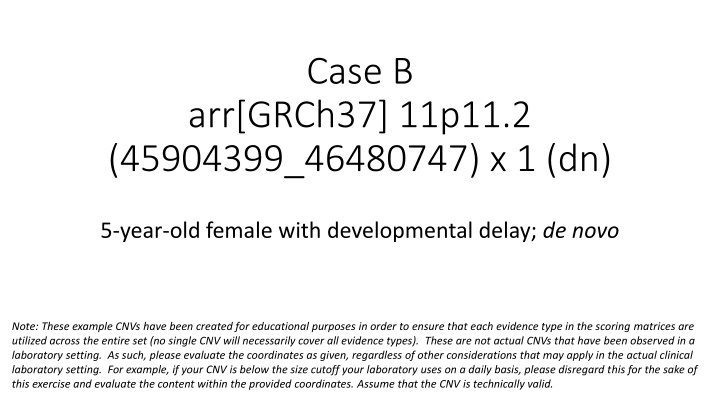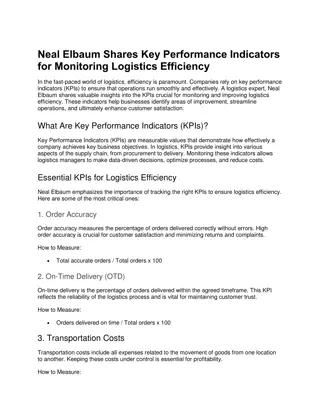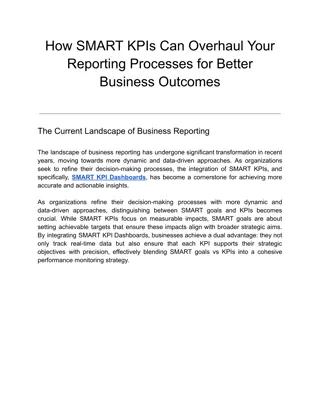Workshop on 6G KPIs and Measurement Methods
This workshop on 6G Key Performance Indicators (KPIs) explores the motivation, methodologies, and target values in the context of B5G/6G networks. Industry experts present insights on measuring and monitoring KPIs for 6G networks, including AI, networking infrastructure, and industry environments. The agenda covers topics such as 6G network resource management, challenges in KPI measurement techniques, and tools for validation. Participants will gain valuable information on the latest advancements in 6G technology and network performance evaluation strategies. Visit the workshop webpage for more details.
Download Presentation

Please find below an Image/Link to download the presentation.
The content on the website is provided AS IS for your information and personal use only. It may not be sold, licensed, or shared on other websites without obtaining consent from the author.If you encounter any issues during the download, it is possible that the publisher has removed the file from their server.
You are allowed to download the files provided on this website for personal or commercial use, subject to the condition that they are used lawfully. All files are the property of their respective owners.
The content on the website is provided AS IS for your information and personal use only. It may not be sold, licensed, or shared on other websites without obtaining consent from the author.
E N D
Presentation Transcript
Case B arr[GRCh37] 11p11.2 (45904399_46480747) x 1 (dn) 5-year-old female with developmental delay; de novo Note: These example CNVs have been created for educational purposes in order to ensure that each evidence type in the scoring matrices are utilized across the entire set (no single CNV will necessarily cover all evidence types). These are not actual CNVs that have been observed in a laboratory setting. As such, please evaluate the coordinates as given, regardless of other considerations that may apply in the actual clinical laboratory setting. For example, if your CNV is below the size cutoff your laboratory uses on a daily basis, please disregard this for the sake of this exercise and evaluate the content within the provided coordinates. Assume that the CNV is technically valid.
Clinical Information arr[GRCh37] 11p11.2(45904399_46480747) x 1 (dn) 5-year-old female with developmental delay; de novo Use the LOSS scoring metric
Section 1: Initial Assessment of Genomic Content Case B Genes contained Would apply category 1A (contains protein-coding or other known functionally important elements), as this deletion includes several protein-coding genes. 0 points; continue evaluation Total: 0 points
Section 2: Overlap with Established/Predicted HI or Established Benign Genes/Genomic Regions Case B overlaps a ClinGen curated pathogenic region Part of the Potocki Shaffer region (HI Score of 3)
Zoom out to appreciate the context Both include PHF21A Our Case (Case B) Curated Potocki Shaffer region
Potocki-Shaffer syndrome ClinGen dosage curation results for the region: HI score = 3, TS score = 0 as of December 2013 Loss of this region results in Potocki-Shaffer syndrome, a contiguous gene deletion syndrome Characterized by: developmental delay, intellectual disability, multiple exostoses, parietal foramina, enlarged anterior fontanel, etc. Loss of the EXT2 gene is thought to cause the multiple exostoses phenotype Loss of the ALX4 gene is thought to cause the parietal foramina phenotype Our case (Case B) does not involve either of these genes, but does overlap several genes at the proximal end of the curated region, including PHF21A Use Category 2B due to partial overlap; continue evaluation Total: 0 points
HI Predictors Since no points were awarded for overlapping with a known HI gene or genomic region, it would be appropriate to consider whether points should be awarded for HI predictors. 2 genes in the interval meet current criteria (boxed in red). Remember, category 2H can only be scored ONCE, regardless of how many genes in the interval meet the criteria. Total: 0.15 points
Section 3: Evaluation of Gene Number There are 11 protein-coding genes in the interval (category 3A, 0 points). Total: 0.15 points
Section 4: Detailed Evaluation of Genomic Content Where to start? PHF21A has already been evaluated by ClinGen Dosage (though did not receive an HI score of 3 when originally evaluated) logical starting point
https://dciw.clinicalgenome.org/clingen_gene.cgi?sym=PHF21A Use this evidence as a starting point for Section 4. Check for new evidence since May 2019.
Literature-based evidence from the ClinGen dosage evaluation Hamanaka et al. (2019) (PMID:30487643) Describes 3 de novo putative LOF variants in PHF21A (NM_001101802.1) in individuals with non-specific neurodevelopmental phenotypes (variable intellectual disability, developmental delay, autistic features, epilepsy) All 3 variants identified on trio exome sequencing (parental relationships can be considered confirmed); none of the variants are in gnomAD as of March 2020 Case 1: c.1220dupC (p.Glu408Argfs*3): 0.15 points Case 2: c.1738C>T (p.Arg508*): This variant is in the penultimate exon, and is not expected to undergo nonsense mediated decay. No functional studies were performed to demonstrate the effect of this variant. A subsequent paper reports this variant (de novo) in 2 additional probands (Kim et al., discussed later in the presentation). These authors note that this variant would remove the LZD2 functional domain; because of this, we will count each instance of this variant at a downgraded score of 0.075. Case 3: c.657_658insAA (p.Pro220Asnfs*48):0.15 points Total: 0.525 points
Literature-based evidence from the ClinGen dosage evaluation EuroEPINOMICS-RES Consortium et al. (2014) (PMID:25262651): Reported exome sequencing data of 356 trios with epileptic encephalopathies, infantile spasms, and/or Lennox Gastaut syndrome Parental relationships can be considered confirmed In the supplemental material, the authors report a single individual (isnd38199aic1) with a de novo splice acceptor variant (a T>C change at genomic position 45958122 on chromosome 11 (GRCh37)). This individual was said to have infantile spasms; no additional information is available. Because of lack of phenotypic information, consider this a non-specific phenotype Variant not present in gnomAD as of March 2020 0.15 points Total: 0.675 points
Literature-based evidence from the ClinGen dosage evaluation Iossifov et al. 2014 (PMID:25363768): Reports exome sequencing data for more than 2500 families (proband with autism, unaffected sibling, and parents) from the Simons Simplex Collection Parental relationships can be considered confirmed A single female proband with autism (Family ID 11339) was reported to have a de novo frameshift variant in PHF21A (11:45971023:CT:C) Variant not found in gnomAD as of March 2020 No further clinical information is available Non-specific phenotype 0.15 points Total: 0.825 points
Have there been any subsequent publications? Yes! This paper came out in October 2019. The ClinGen dosage evaluation was completed in May 2019.
Total: 0.975 points Kim et al. 2019 (PMID:31649809) Describes 7 individuals with variants in PHF21A and variable neurodevelopmental phenotypes, including intellectual disability, developmental delay, autism spectrum disorders, and seizures. Patient Variant Inheritance Mode of Testing Predicted Consequence Score 1 c.1955delC (p.Pro652LeufsX104) De novo Trio exome Frameshift; expected to result in elongated protein; not expected to result in NMD; expected to truncate intrinsically disordered region (IDR) 0; unclear how this will affect protein; authors cannot r/o GOF or dominant negative 2 c.1285G>A (p.Gly429Ser) De novo Trio panel (520 genes) Missense; thought to result in LOF due compromise in AT Hook: DNA interactions (protein modeling only) 0 (Missense variant, hypothesized but not demonstrated LOF) 3 c.1956delT (p.Pro652ProfsX104) De novo Trio exome Frameshift; expected to result in elongated protein; not expected to result in NMD; expected to truncate IDR 0; unclear how this will affect protein; authors cannot r/o GOF or dominant negative 4 c.1738C>T (p.Arg580Ter) De novo Trio panel (520 genes) Premature stop codon located 48 nucleotides upstream of the last exon-exon junction; not expected to undergo NMD, but is expected to be missing LZD2 functional domain 0.075 downgrade due to NMD, but scoring due to missing fx domain 5 c.1471dupT (p.Cys491LeufsX81) Not found in mother Exome Expected to result in truncated protein undergoing NMD; expected to be missing LZD2 and PHD finger domains 0 Unknown inheritance, nonspecific phenotype 6 c.1738C>T (p.Arg580Ter) De novo Trio panel (520 genes) Premature stop codon located 48 nucleotides upstream of the last exon-exon junction; not expected to undergo NMD, but is expected to be missing LZD2 functional domain 0.075 downgrade due to NMD, but scoring due to missing fx domain 7 c.2024delA, p.Gln675ArgfsX81) De novo Trio exome Frameshift; expected to result in elongated protein; not expected to result in NMD; expected to truncate IDR 0; unclear how this will affect protein; authors cannot r/o GOF or dominant negative
Additional supportive information There are 3 additional de novo putative LOF variants in DECIPHER, each classified as likely pathogenic : 379277: c.1147+1G>A 301795: c.703C>T (p.Arg235Ter) 292807: c.1855A>T (p.Lys619Ter) (last exon) Each proband is described as having variable neurodevelopmental disorder(s) Testing methodology and previous testing unknown Unknown if parental relationships are confirmed
Additional supportive information Kim et al. 2012 describe 3 patients with apparently balanced de novo translocations in which one breakpoint disrupts PHF21A. These individuals are noted to have neurodevelopmental and craniofacial phenotypes consistent with what has previously been reported in Potocki-Shaffer syndrome. For at least one of the subjects, the second breakpoint was found to be in a region devoid of annotated genes. The authors also demonstrated that zebrafish orthologs are expressed in a manner consistent with a function in neurofacial and craniofacial development, and suppression of the [zebrafish ortholog] led to both craniofacial abnormalities and neuronal apoptosis.
Additional supportive information Porter et al. 2018 (PMID:28571721): RNA-Seq of PHF21A-deficient patient cells revealed 1,885 commonly misregulated genes Pathway analysis showed downregulation of pathways relevant to learning and memory, including cAMP-mediated signaling Reporter assays showed PHF21A is required for full induction of the cAMP- mediated transcriptional response PHF21A-deficient patient cells exhibited delayed transcription of immediate early genes following cAMP signaling.
Section 5: Evaluation of Inheritance Pattern/Family History for Patient Being Studied Our patient is said to have developmental delay This is consistent with the expected phenotype, though relatively non-specific The variant is said to be de novo Since original testing done by array CGH, confirmatory parental testing likely did not confirm both parental relationships Use category 5A (0.10 points) Total: >1 point
Conclusion Classification: Pathogenic Though the current ClinGen Dosage Sensitivity curation for the PHF21A gene is a 2, newer published information and additional supportive information suggest that loss of this gene results in variable neurodevelopmental phenotypes. This patient would not be expected to have the full Potocki-Shaffer phenotype (including multiple exostoses and parietal foramina) as the EXT2 and ALX4 genes are not involved.























